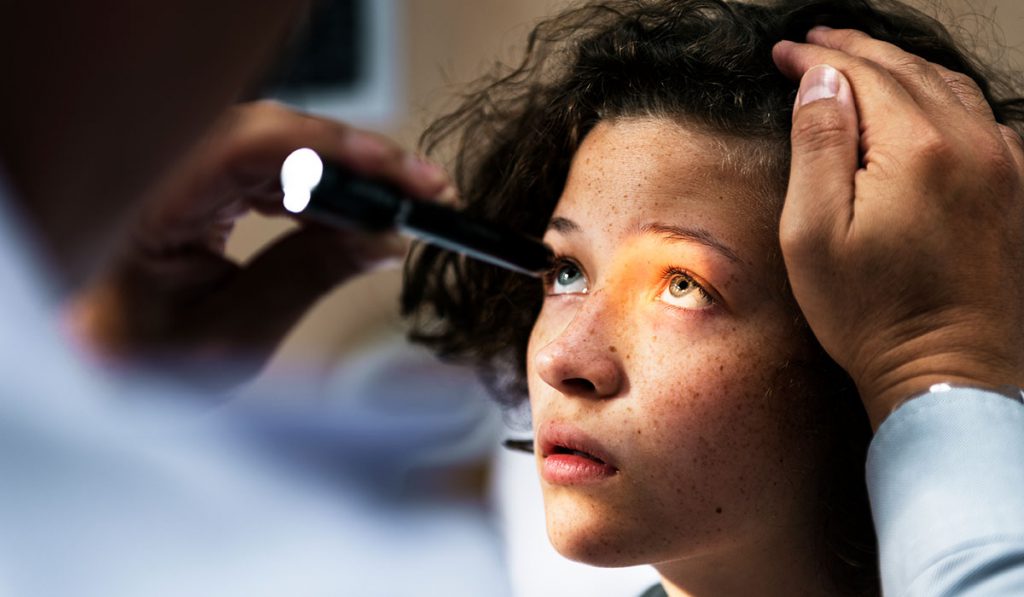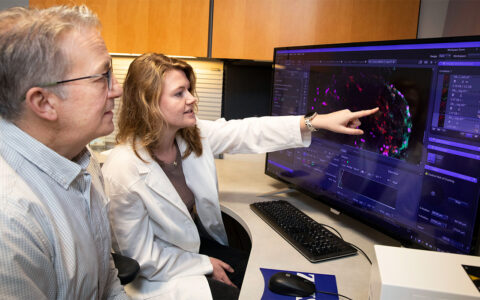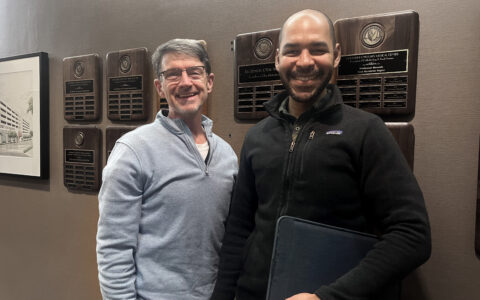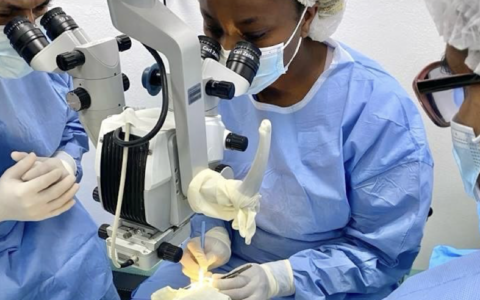Leber hereditary optic neuropathy (LHON) is a rare, maternally-inherited condition that causes degeneration of retinal ganglion cells and their axons. It is primarily characterized by bilateral, painless loss of central vision during young adulthood.
“Until recently, there’s been no effective treatment for Leber’s,” said Sean Donahue, M.D., Ph.D., Sam and Darthea Coleman Professor of Pediatric Ophthalmology and vice chair for clinical affairs at Vanderbilt Eye Institute. “The gene mutations were identified 30 years ago, but we haven’t had a delivery mechanism for gene therapy.”
Promising Trials
The phase 3 REFLECT trial is testing the safety and efficacy of the gene therapy lenadogene nolparvovec (marketed as LUMEVOQ). Vanderbilt Eye Institute was one of the first sites in the U.S. to offer enrollment in the trial and one of just a few to offer it to children.
REFLECT is a randomized, double-blinded, placebo-controlled trial. All study participants receive the gene therapy in their eye with poorer vision. Half also received the therapy in their better eye, half a placebo.
Initial results of the REFLECT trial from the manufacturer demonstrate that lenadogene nolparvovec treatment shows statistically significant visual acuity improvement from baseline. These results bolster the evidence provided by data from the phase 3 clinical trials REVERSE and RESCUE, and the long-term follow-up study RESTORE.
The Case for Compassionate Use
“Leber’s progresses very rapidly,” explained Donahue. “A patient can go blind in a short time. But because one eye is injected with placebo and subject to infection most institutional review boards won’t approve a trial like REFLECT.”
Two patients who came to Vanderbilt with LHON were younger than the allowable age and therefore did not qualify for clinical trial enrollment. A team from the Vanderbilt Institute for Clinical and Translational Research (VICTR) assisted patients in receiving the investigational drug through the FDA Expanded Access program.
As the study closes, there are additional patients identified by the recruitment panel as diagnosed with LHON. The VICTR team arranged compassionate use exemptions for these patients on an individual basis, “even without the trial and full FDA approval,” Donahue said. Researchers are now pursuing a large-scale compassionate use exemption.
Mechanisms of the Therapy
LHON is caused by specific mutations in mitochondrial DNA encoding ND1, ND4 or ND6 proteins. The gene therapy delivery mechanism is GS010, a recombinant adenovirus that encodes the human wild-type ND4 protein.
A proprietary targeting sequence transports the messenger RNA from the nucleus directly to the outer membrane of the mitochondria. There, the ND4 proteins are synthesized and incorporated into the mitochondria. Wild-type ND4 proteins then integrate into the respiratory chain and rescue the deficiency.
LHON is a symmetric disease. Ninety-seven percent of subjects have bilateral involvement at less than one year of onset of vision loss, Donahue says, and in 25 percent of cases, vision loss occurs in both eyes simultaneously.
A Contralateral Effect
While REFLECT demonstrates better efficacy for bilaterally-treated subjects, a contralateral effect observed with placebo was also present, consistent with evidence provided by the sham-controlled REVERSE and RESCUE.
David Calkins, Ph.D., Denis O’Day Professor of Ophthalmology and Visual Sciences and vice chair for research at Vanderbilt Eye Institute, has been studying a bilateral effect, where treatment of degenerative disease in one eye also causes improvement in the other eye and may occur in patients with glaucoma and other degenerative eye diseases. Using a non-human primate model, Calkins and colleagues have investigated the possibility of biodistribution in lenadogene nolparvovec therapy for LHON.
Their latest results, published in Molecular Therapy, suggest that lenadogene nolparvovec transfers from the injected to the noninjected eye, thus providing a potential explanation for the improvement of visual function observed in both eyes of treated patients with LHON.
Hope for the Future
If gene therapy in one eye can improve visual acuity in both, it may indicate the two optic nerves are talking to one another,” Calkins said. “This has huge clinical ramifications.”
While lenadogene nolparvovec has not yet received full FDA approval, Donahue is optimistic about gene therapy for treating LHON.
“In the past, Leber’s has meant almost certain blindness in young adults. Hopefully, gene therapy will become part of our armamentarium for treating this brutal disease.”





